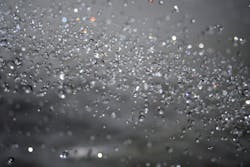WRF Releases Preliminary Findings of Direct Potable Reuse Study
The Water Research Foundation (WRF) has released interim results from the project “Blending Requirements for Water from Direct Potable Reuse Treatment Facilities” (#4536). The objective of this project is to provide guidance for the appropriate use of blending as part of a direct potable reuse (DPR) project. The study examines the impact of four blending variables: source water type, blending location, recycled water ratio and type of advanced treatment train. A video, Exploring Potable Reuse to Diversify Water Supplies, provides a preview of the project.
Four utilities are participating in the bench-scale treatment/distribution system study: Santa Clara Valley Water District (SCVWD), the city of Ventura, Clark County Water Reclamation District and Los Angeles Department of Water & Power (LADWP). The bench-scale simulations were based on the participating utilities’ full-scale processes. The parameters tested include pathogens, emerging contaminants, regulated contaminants, corrosion-related issues, and general parameters, such as pH and turbidity.
Preliminary findings include:
- Blending with DPR waters may help lower trihalomethanes (THMs).
- Blended water quality and bacterial activity appear to be predominant factors for corrosion products in premise plumbing testing.
- Antibiotic resistance gene (ARG) composition in DPR blends appears similar or better than in potable water tests.
Bench testing using water from SCVWD, the city of Ventura and Clark County Water Reclamation District is complete, and the data is being analyzed. Bench testing using water from LADWP is in progress. The research team will issue a survey to approximately 20 participating utilities to understand their perspective on blending and gather water quality data. The final project results will be published in early 2018.
WRF has been conducting innovative research on potable and non-potable reuse for more than 40 years. Additionally, WRF has more than a dozen ongoing projects on reuse, including:
- “Assessment of Technologies for Evaluating and Demonstrating Safety of Water from Direct Potable Reuse Treatment Facilities” (project #4508) will evaluate the safety of existing or future DPR scenarios and help facilitate a proactive DPR monitoring process that is protective of public health. Fifteen utilities from California, Georgia, Colorado, Arizona, Virginia and Singapore are participating in the project. The literature review for this project was published in May 2016. In addition to project #4536, the video Exploring Potable Reuse to Diversify Water Supplies previews this project.
- “Building-Scale Treatment for Direct Potable Water Reuse & Intelligent Control for Real Time Performance Monitoring” is a tailored collaboration with San Francisco Public Utilities Commission (project #4691). This project will use building-scale treatment, proven purification processes, real-time online monitoring, and advanced analytical tools to demonstrate water quality and public health protection in real time.
- LADWP is leading a tailored collaboration project titled “Soil Aquifer Treatment Characterization with Soil Columns for Groundwater Recharge in the San Fernando Valley” (project #4600). This project examines the soil aquifer treatment (SAT) process and how it may impact potable reuse in the coming years. Soil columns will be operated to mimic a potential full-scale groundwater recharge practice to characterize the effectiveness of SAT.
- WRF has funded a new tailored collaboration project with Orange County Water District (OCWD) of California, “Kinetics Modeling and Experimental Investigation of Chloramine Photolysis in Ultraviolet-Driven Advanced Water Treatment” (project #4699). This work will elucidate the ultraviolet-driven advanced oxidation process (AOP) of trace organic contaminants in wastewater effluent on the basis of one oxidant (i.e., chloramine). The project will identify pathways for applying the new knowledge in partnership with OCWD, which operates the world’s largest advanced water treatment system for potable reuse.
“Freshwater supplies are dwindling in many regions within the U.S. and around the world due to climate change, competing demands, and expanding and shifting populations,” said Rob Renner, CEO of WRF. “With dozens of completed and ongoing projects, the Water Research Foundation will continue to be a leader in ensuring that these regions can adopt potable reuse as a practical option to provide safe drinking water to their communities.”
For more information, visit the 2014 Advances in Water Research feature on potable reuse, or contact Katie Henderson, WRF research manager, at [email protected] or 303.347.6108.
Source: Water Research Foundation
